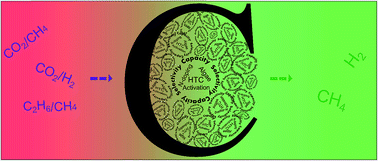Unprecedented performance of N-doped activated hydrothermal carbon towards C2H6/CH4, CO2/CH4, and CO2/H2 separation†
Abstract
A series of N-doped porous carbons with different textural properties and N contents was prepared from a mixture of algae and glucose and their capability for the separation of CO2/CH4, C2H6/CH4, and CO2/H2 binary mixtures under different conditions (bulk pressure, mixture composition, and temperature) were subsequently assessed in great detail. It was observed that the gas (C2H6, CO2, CH4, and H2) adsorption capacity at different pressure regions was primarily governed by different adsorbent parameters (N level, narrow micropore volume, and BET specific surface area). More interestingly, it was found that N-doping can selectively enhance the heats of adsorption of C2H6 and CO2, while it had a negligible effect on those of CH4 and H2. The adsorption equilibrium selectivities for separating C2H6/CH4, CO2/CH4, and CO2/H2 gas mixture pairs on the porous carbons were predicted using the ideal adsorbed solution theory (IAST) based on pure-component adsorption isotherms. In particular, sample NAHA-1 exhibited by far the best performance (in terms of gas adsorption capacity and selectivity) reported for porous carbons for the separation of these three binary mixtures. More significantly, NAHA-1 carbon outperforms many of its counterparts (e.g. MOFs and zeolites), emphasizing the important role of carbonaceous adsorbents in gas purification and separation.


 Please wait while we load your content...
Please wait while we load your content...